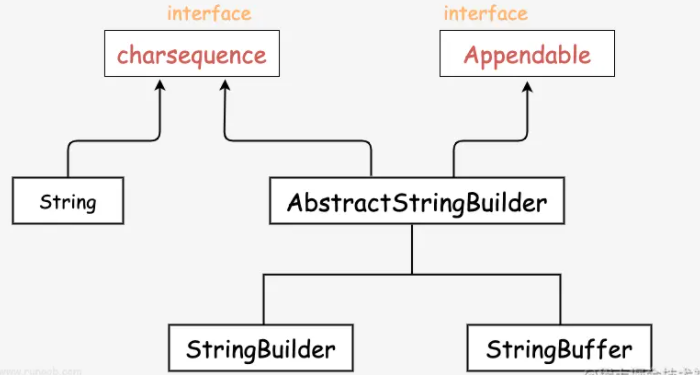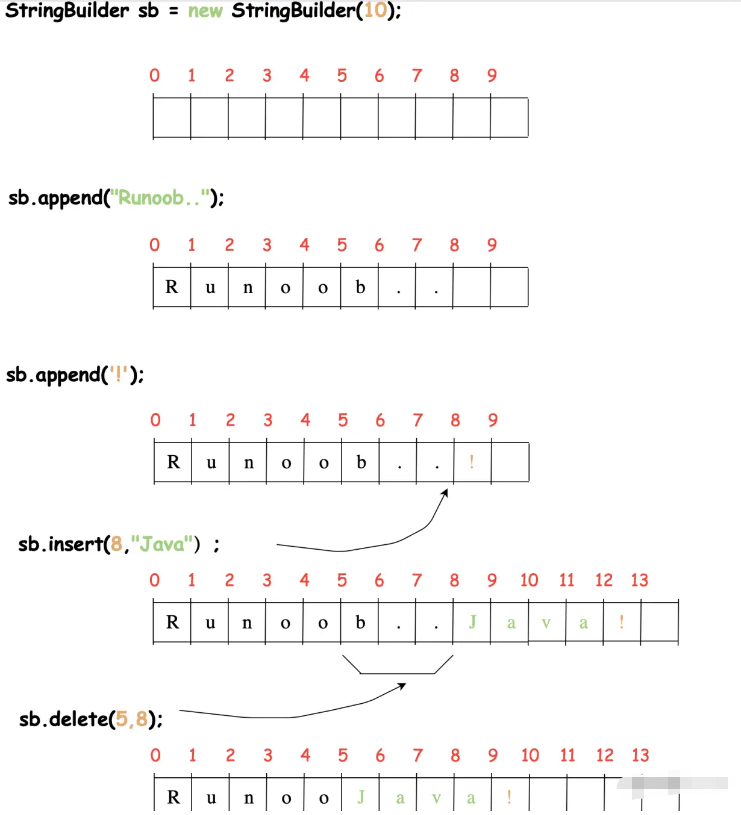How to use StringBuffer and StringBuilder in Java
When modifying strings, you need to use the StringBuffer and StringBuilder classes. Different from the String class, objects of the StringBuffer and StringBuilder classes can be modified multiple times without generating new unused objects .

StringBuffer: When using the StringBuffer class, the StringBuffer object itself will be operated every time instead of generating a new object, so if you need to It is recommended to use StringBuffer to modify strings.
StringBuilder: The StringBuilder class was proposed in Java 5. The biggest difference between it and StringBuffer is that the methods of StringBuilder are not thread-safe (cannot be accessed synchronously). Since StringBuilder has a speed advantage compared to StringBuffer, it is recommended to use the StringBuilder class in most cases.
StringBuilder usage example:
public class RunoobTest{
public static void main(String args[]){
StringBuilder sb = new StringBuilder(10);
sb.append("Runoob..");
System.out.println(sb);
sb.append("!");
System.out.println(sb);
sb.insert(8, "Java");
System.out.println(sb);
sb.delete(5,8);
System.out.println(sb);
}
}
// 实例编译运行结果如下:
// Runoob..
// Runoob..!
// Runoob..Java!
// RunooJava!
#However, when the application requires thread safety, the StringBuffer class must be used. StringBuffer usage example:
public class Test {
public static void main(String args[]) {
StringBuffer sBuffer = new StringBuffer("稀土掘金:");
sBuffer.append("www");
sBuffer.append(".juejin");
sBuffer.append(".cn");
System.out.println(sBuffer);
}
}
// 实例编译运行结果如下:
// 稀土掘金:www.juejin.cnStringBuffer method
Main methods supported by the StringBuffer class:
| Serial number | Method description |
|---|---|
| 1 | public StringBuffer append(String s), append the specified string to this character sequence |
| 2 | public StringBuffer reverse(), replace this character sequence with its reversed form |
| 3 | public delete( int start, int end), remove the characters |
| 4 | public insert(int offset, int i), change the int parameter from the substring of this sequence The string representation of is inserted into this sequence |
| 5 | insert(int offset, String str), inserts the string of the str parameter into this sequence |
| 6 | replace(int start, int end, String str) , replaces the characters in the substring of this sequence with the characters in the given String |
Other common methods of the StringBuffer class:
| Serial number | Method description |
|---|---|
| 1 | int capacity(), returns the current capacity |
| 2 | char charAt(int index), returns the specified index in this sequence The char value at |
| 3 | void ensureCapacity(int minimumCapacity) ensures that the capacity is at least equal to the specified minimum value |
| 4 | void getChars(int srcBegin, int srcEnd, char[] dst, int dstBegin), copies characters from this sequence to the target character array dst |
| 5 | int indexOf(String str), returns the index of the first occurrence of the specified substring in the string |
| 6 | int indexOf( String str, int fromIndex), starting from the specified index, returns the index of the first occurrence of the specified substring in the string |
| 7 | int lastIndexOf(String str), returns the index of the last occurrence of the specified substring in this string |
| 8 | int lastIndexOf(String str, int fromIndex), returns the index of the last occurrence of the specified character in this string, and performs a reverse search starting from the specified index |
| 9 | int length( ), returns the length (number of characters) |
| 10 | void setCharAt(int index, char ch), sets the character at the given index to the value of the ch parameter |
| 11 | void setLength(int newLength), set the length of the character sequence |
| 12 | CharSequence subSequence(int start, int end), returns a new character sequence that is a subsequence of this sequence |
| 13 | String substring(int start ), returns a new String, which contains the character subsequence currently contained by this character sequence |
| 14 | String substring(int start, int end), returns A new String that contains the character subsequence currently contained by this sequence |
| 15 | String toString(), returns the string representation of the data in this sequence |
Method instance:\color{red}{Method instance:}Method instance:
reverse() Method instance:
public synchronized StringBuffer reverse()
Description:
Replace this character sequence with its reversed form.
Parameters:
None
Return value:
The reversed form of the character sequence.
public class Test {
public static void main(String args[]) {
String string="niJeuJ";
String reverse = new StringBuffer(string).reverse().toString();
System.out.println("字符串反转前:"+string);
System.out.println("字符串反转后:"+reverse);
}
}
// 以上程序执行结果为:
// 字符串反转前:niJeuJ
// 字符串反转后:JueJinThe above is the detailed content of How to use StringBuffer and StringBuilder in Java. For more information, please follow other related articles on the PHP Chinese website!

Hot AI Tools

Undresser.AI Undress
AI-powered app for creating realistic nude photos

AI Clothes Remover
Online AI tool for removing clothes from photos.

Undress AI Tool
Undress images for free

Clothoff.io
AI clothes remover

Video Face Swap
Swap faces in any video effortlessly with our completely free AI face swap tool!

Hot Article

Hot Tools

Notepad++7.3.1
Easy-to-use and free code editor

SublimeText3 Chinese version
Chinese version, very easy to use

Zend Studio 13.0.1
Powerful PHP integrated development environment

Dreamweaver CS6
Visual web development tools

SublimeText3 Mac version
God-level code editing software (SublimeText3)

Hot Topics
 Break or return from Java 8 stream forEach?
Feb 07, 2025 pm 12:09 PM
Break or return from Java 8 stream forEach?
Feb 07, 2025 pm 12:09 PM
Java 8 introduces the Stream API, providing a powerful and expressive way to process data collections. However, a common question when using Stream is: How to break or return from a forEach operation? Traditional loops allow for early interruption or return, but Stream's forEach method does not directly support this method. This article will explain the reasons and explore alternative methods for implementing premature termination in Stream processing systems. Further reading: Java Stream API improvements Understand Stream forEach The forEach method is a terminal operation that performs one operation on each element in the Stream. Its design intention is
 PHP: A Key Language for Web Development
Apr 13, 2025 am 12:08 AM
PHP: A Key Language for Web Development
Apr 13, 2025 am 12:08 AM
PHP is a scripting language widely used on the server side, especially suitable for web development. 1.PHP can embed HTML, process HTTP requests and responses, and supports a variety of databases. 2.PHP is used to generate dynamic web content, process form data, access databases, etc., with strong community support and open source resources. 3. PHP is an interpreted language, and the execution process includes lexical analysis, grammatical analysis, compilation and execution. 4.PHP can be combined with MySQL for advanced applications such as user registration systems. 5. When debugging PHP, you can use functions such as error_reporting() and var_dump(). 6. Optimize PHP code to use caching mechanisms, optimize database queries and use built-in functions. 7
 PHP vs. Python: Understanding the Differences
Apr 11, 2025 am 12:15 AM
PHP vs. Python: Understanding the Differences
Apr 11, 2025 am 12:15 AM
PHP and Python each have their own advantages, and the choice should be based on project requirements. 1.PHP is suitable for web development, with simple syntax and high execution efficiency. 2. Python is suitable for data science and machine learning, with concise syntax and rich libraries.
 PHP vs. Other Languages: A Comparison
Apr 13, 2025 am 12:19 AM
PHP vs. Other Languages: A Comparison
Apr 13, 2025 am 12:19 AM
PHP is suitable for web development, especially in rapid development and processing dynamic content, but is not good at data science and enterprise-level applications. Compared with Python, PHP has more advantages in web development, but is not as good as Python in the field of data science; compared with Java, PHP performs worse in enterprise-level applications, but is more flexible in web development; compared with JavaScript, PHP is more concise in back-end development, but is not as good as JavaScript in front-end development.
 PHP vs. Python: Core Features and Functionality
Apr 13, 2025 am 12:16 AM
PHP vs. Python: Core Features and Functionality
Apr 13, 2025 am 12:16 AM
PHP and Python each have their own advantages and are suitable for different scenarios. 1.PHP is suitable for web development and provides built-in web servers and rich function libraries. 2. Python is suitable for data science and machine learning, with concise syntax and a powerful standard library. When choosing, it should be decided based on project requirements.
 Java Program to Find the Volume of Capsule
Feb 07, 2025 am 11:37 AM
Java Program to Find the Volume of Capsule
Feb 07, 2025 am 11:37 AM
Capsules are three-dimensional geometric figures, composed of a cylinder and a hemisphere at both ends. The volume of the capsule can be calculated by adding the volume of the cylinder and the volume of the hemisphere at both ends. This tutorial will discuss how to calculate the volume of a given capsule in Java using different methods. Capsule volume formula The formula for capsule volume is as follows: Capsule volume = Cylindrical volume Volume Two hemisphere volume in, r: The radius of the hemisphere. h: The height of the cylinder (excluding the hemisphere). Example 1 enter Radius = 5 units Height = 10 units Output Volume = 1570.8 cubic units explain Calculate volume using formula: Volume = π × r2 × h (4
 PHP: The Foundation of Many Websites
Apr 13, 2025 am 12:07 AM
PHP: The Foundation of Many Websites
Apr 13, 2025 am 12:07 AM
The reasons why PHP is the preferred technology stack for many websites include its ease of use, strong community support, and widespread use. 1) Easy to learn and use, suitable for beginners. 2) Have a huge developer community and rich resources. 3) Widely used in WordPress, Drupal and other platforms. 4) Integrate tightly with web servers to simplify development deployment.
 Create the Future: Java Programming for Absolute Beginners
Oct 13, 2024 pm 01:32 PM
Create the Future: Java Programming for Absolute Beginners
Oct 13, 2024 pm 01:32 PM
Java is a popular programming language that can be learned by both beginners and experienced developers. This tutorial starts with basic concepts and progresses through advanced topics. After installing the Java Development Kit, you can practice programming by creating a simple "Hello, World!" program. After you understand the code, use the command prompt to compile and run the program, and "Hello, World!" will be output on the console. Learning Java starts your programming journey, and as your mastery deepens, you can create more complex applications.






